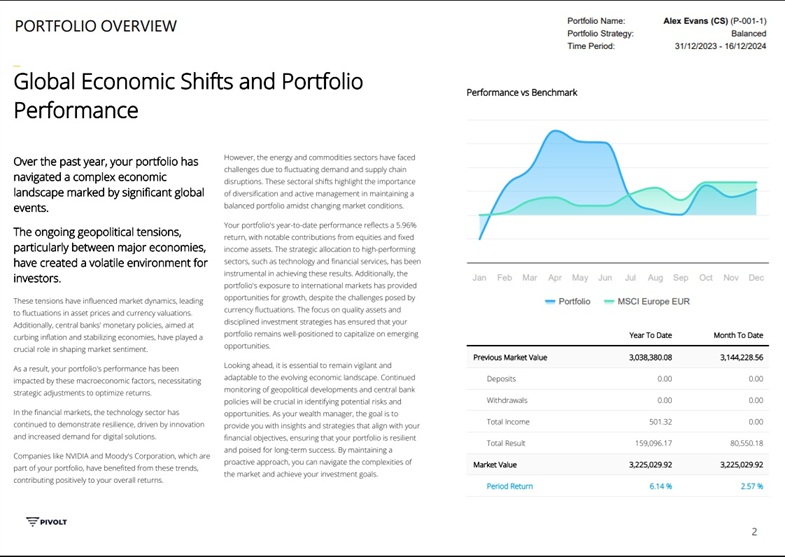
Investors are constantly exposed to a barrage of headlines—interest rate hikes, geopolitical shocks, inflation reports—each carrying signals that may or may not affect their portfolios. But without a framework to interpret these events, even seasoned investors struggle to connect cause and effect. How does a currency crisis abroad impact my dividend-paying equities? What does a new emissions cap mean for my industrial holdings? How does a change in tax policy ripple through my real estate holdings?
News cycles move faster than most wealth platforms can process. Information flows in real time, but investor understanding lags behind. Traditional dashboards are not designed to explain—they’re built to report. The gap between what happened and what it means widens, creating doubt and emotional reactions that can undermine long-term strategy. This gap is where smart narratives—or "market storylines"—can play a critical role.
When events are not linked to portfolio mechanics, the investor's mental model collapses. Many act prematurely—selling at the worst moment or shifting strategies without a solid basis. It’s not a question of intelligence, but context. The investor doesn't need more information—they need the right interpretation, customized to their position.
This is especially true in diversified portfolios where second- and third-order effects of macro events ripple across assets in unpredictable ways. Most investors are not equipped to parse these layers in real time. They need narrative explanations that match their holdings, not generic economic commentary. And most importantly, they need to understand not only the "what," but the "why" behind performance changes.
The failure of static reports to capture evolving market sentiment contributes to this problem. Reports are often backward-looking, reducing complex, real-time market dynamics to a handful of bar charts. The lack of narrative continuity between market signals and portfolio outcomes is a missed opportunity in modern wealth management.
Financial data is abundant—but meaning is scarce. Investors crave not just dashboards but understanding. Narrative bridges that gap. A well-constructed storyline doesn’t just describe performance—it shows how macro events cascade through sectors, asset classes, and finally, portfolios. This shift from reporting to storytelling is more than semantic. It transforms the investor experience from reactive to informed.
Consider a storyline that connects rising interest rates to a decline in growth equities, and then shows the subsequent impact on a client’s specific tech allocation. This builds understanding. And understanding builds confidence. In a market full of noise, narratives quiet the fear by delivering clarity and relevance—without overwhelming the investor with jargon or noise.
These narratives can also highlight divergence—why two similar portfolios responded differently to the same market event. This allows wealth managers to demonstrate nuance and intentionality in portfolio construction. Instead of defending results, they explain them with transparency. That’s a much stronger position for client retention and trust.
The best narratives are anchored in real data but humanized through context. They surface what matters—without diluting complexity or over-simplifying. They invite the investor into the reasoning behind decisions. As wealth firms embrace personalization, this layer of storytelling becomes essential—not optional. It’s not just about what happened; it’s about why it matters to you.
And unlike static performance reports, storylines evolve. They track the market’s pulse and show how expectations and outcomes diverge or align over time. This continuity reinforces investor learning, helping clients grow more sophisticated over time. That kind of insight builds loyalty—because it builds shared understanding.
The greatest value of storylines in wealth management is their ability to highlight causality. Investors don’t just want to know that their portfolio dipped—they want to know why. And more than that, they want to know what’s likely to happen next. When storylines draw a clear line between market news and portfolio movement, they shift perception from surprise to strategy.
A storyline could begin with a central bank decision, flow through bond yield movements, and land on the impact to duration-sensitive assets. For an investor holding such assets, this is not noise—it’s personalized intelligence. It removes randomness from performance and replaces it with logic. That builds confidence in both the portfolio and the advisor.
Context also helps investors avoid overreaction. When a portfolio loss is explained in light of global dynamics—and tied to long-term strategy—it feels less like failure and more like process. Storylines normalize volatility as a function of positioning and expectation. This encourages discipline and supports better decision-making across cycles.
This framing isn’t about hand-holding. It’s about empowering. By tracing cause and effect, storylines elevate the conversation with investors from what’s wrong to what’s happening. That subtle shift changes how investors view their wealth platform. It becomes a strategic partner, not just a data hub.
Most importantly, this model can be applied across asset classes—from equities to alternatives—and across investor profiles. Whether risk-averse or opportunistic, every investor benefits from clarity. And storylines are how clarity scales in a complex environment.
➤ See how the Storyboard brings narratives to life on the Pivolt platform

Financial complexity is only growing. The pace of information, the interdependence of markets, and the diversification of portfolios make it harder than ever for investors to understand what truly matters. And yet, the demand for clarity has never been greater. Static tools won’t solve this. Storylines will. Because they reflect the way humans actually understand risk, change, and consequence.
A story is not just an explanation—it’s a mental model. It allows an investor to follow a chain of cause and effect across events, asset classes, and strategy. It also allows wealth managers to elevate their communication—away from “what happened” and toward “why this matters.” That’s where trust is built. That’s where advice turns into insight.
The benefits are mutual. Clients feel smarter and more involved. Advisors feel heard and less reactive. The platform becomes not a passive database but a living, evolving guide that adapts to the investor’s context. This is the shift from reporting to reasoning—from numbers to narrative. And it is long overdue.
Wealth platforms that embrace this transition will not only win attention—they will earn trust. They will turn dashboards into dialogues. And in doing so, they’ll bridge the final gap in wealth technology: the one between insight and understanding. It’s not about simplifying the world. It’s about contextualizing it.
Pivolt is redefining the client experience—not by adding more data, but by delivering better stories. Stories that educate. Stories that respond. Stories that connect performance to purpose. Because when investors understand the “why,” they stay for the “what’s next.”